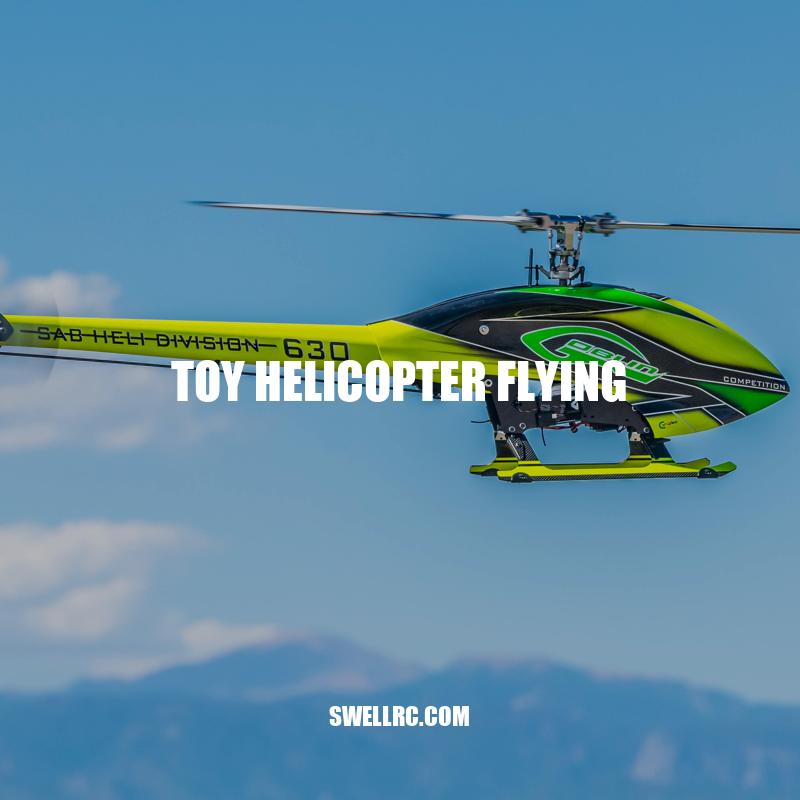Beginner’s Guide to Toy Helicopter Flying
Toy helicopter flying is an exciting and popular activity for people of all ages. These miniature versions of real helicopters come in a variety of shapes, sizes, and designs. Whether you’re a seasoned enthusiast or a newcomer, toy helicopter flying offers a sense of adventure and thrill without leaving the ground. It’s a great way to experience the joy of flying, learn about aerodynamics and physics, and engage in a fun and educational activity. In this article, we’ll explore the different types of toy helicopters, provide tips on how to fly them, and share the benefits of this growing hobby. Whether you’re looking to start a new hobby, expand your flying skills, or simply have fun, toy helicopter flying is an activity worth trying.
Types of Toy Helicopters
There are different types of toy helicopters available in the market, each with its own features, designs, and skill levels required to fly them. Here are the most common types:
- Gyro-Stabilized Toy Helicopters: This type of toy helicopter has built-in gyroscopes that maintain stability in the air. They are easier to fly and require less skill and experience. Popular gyro-stabilized toy helicopters include the Syma S107G, Blade mCX2, and WLtoys V911S.
- Non-Gyro Stabilized Toy Helicopters: This type of toy helicopter does not have built-in gyroscopes and requires more skill and expertise to fly. You will need to control the helicopter’s stability, lift, and direction manually. Some popular non-gyro stabilized toy helicopters include the Blade Nano CP S, E-flite Blade mSR, and XK K124 RC Helicopter.
- Remote Control (RC) Helicopters: These are more advanced toy helicopters that are controlled wirelessly via a remote control. They come in both gyro-stabilized and non-gyro stabilized versions and can be flown both indoors and outdoors. Popular RC helicopters include the Syma S107G, Blade 70S, and DJI Mavic Air 2.
- Micro Helicopters: These are the smallest types of toy helicopters, with a length of about 6 to 12 inches and a weight of 40 to 60 grams. They are suitable for indoor flying and are often gyro-stabilized for ease of control. Popular micro helicopters include the Blade Nano S2, Blade Scout CX, and WLtoys V930.
Before purchasing a toy helicopter, it’s important to consider your flying skills, budget, and personal preferences. Websites like Amazon and HobbyTron offer a wide range of toy helicopters for sale, with customer reviews and ratings to help you make an informed decision.
What is a gyro on a toy helicopter?
A gyro on a toy helicopter is a type of stabilization technology that helps the helicopter maintain a steady and level flight position. It is an electronic device that detects changes in the helicopter’s orientation and sends signals to the helicopter’s flight controls to make adjustments. The gyro can help make it easier to fly a toy helicopter, especially for beginners.
Several websites and products offer gyro technology for toy helicopters, including HobbyTron, Amazon, and Bladez Toyz. These products may have different specs, prices and features.
How to Fly a Toy Helicopter
Flying a toy helicopter can be an exciting experience, but it requires some practice and patience. Here are some basic steps to get started:
- Read the instruction manual carefully and understand the controls and features of your helicopter.
- Find an open and clear space to fly your toy helicopter, away from people, animals, and objects that can obstruct your flight path.
- Turn on the remote control and then the toy helicopter. Make sure that the battery is fully charged before you begin flying.
- Gradually apply pressure to the throttle to lift the helicopter off the ground. Do not rush or force it to go higher too quickly.
- Use small and gentle movements on the controls to keep the helicopter stable in the air and move it in different directions.
- Land your helicopter by lowering the throttle slowly and bringing it down to the ground with a gentle touch.
Here are some additional tips and facts to consider when flying a toy helicopter:
- Practice hovering your helicopter in one spot for a few seconds before attempting to fly it in different directions.
- Use a camera to record your flight and review your performance from different angles.
- Avoid flying in windy or rainy conditions, as this can affect your control and stability.
- Always maintain line of sight with your toy helicopter to prevent it from crashing into any obstacles.
- Try different tricks and maneuvers to enhance your flying skills and impress your audience.
Some websites and products can help you improve your toy helicopter flying skills. For example, HobbyKing offers a range of toy helicopter parts, batteries, and accessories that can enhance your performance and extend your flight time. You can also visit online forums and communities like RCGroups and HeliFreak to connect with other toy helicopter enthusiasts and get advice and tips on how to improve your flying skills.
Here is a table showing different types of toy helicopters and their features:
| Type of Toy Helicopter | Features |
| — | — |
| Gyro-Stabilized | Built-in gyroscopes, easier to fly, beginner-friendly |
| Non-Gyro Stabilized | No built-in gyroscopes, more difficult to fly, requires experience |
| Remote Control | Controlled via remote control, suitable for indoor/outdoor use |
| Micro | Smallest type, lightweight, suitable for indoor flying |
How does a toy helicopter flies?
A toy helicopter flies using the same principles of flight as a real helicopter. Its rotor blades spin quickly, creating lift that allows the helicopter to fly. The remote control allows you to control the angle and speed of the blades, which changes the direction and height of the helicopter. Most toy helicopters are powered by batteries and can fly for a short time before needing to be recharged.
If you’re interested in learning more about how helicopters work, NASA has a great educational website called “Rotorcraft 101” that explains the science behind the flight of helicopters. For those looking to purchase a toy helicopter, popular brands include Syma, CHEERSON, and RCtown.
Tips for Toy Helicopter Flying
If you want to improve your toy helicopter flying skills, here are some tips that can help:
- Always check the battery before flying to ensure that it has enough power for your flight duration.
- Practice hovering and landing your helicopter before attempting to fly it in different directions.
- Use slow and steady movements on the controls to avoid sudden jerks and movements that can cause the helicopter to crash.
- Invest in a high-quality remote control that is reliable and easy to use.
- Join online forums and communities for toy helicopter enthusiasts to connect with other hobbyists, get advice, and share your experiences and knowledge.
- Keep spare parts and tools handy in case you need to perform repairs or maintenance on your helicopter.
Additionally, some websites and products can help you enhance your toy helicopter flying experience. For example, HeliPal offers a range of toy helicopter models, parts, and accessories, as well as a blog with helpful tips, reviews, and guides. You can also find a variety of instructional videos on websites like YouTube and Vimeo, featuring expert toy helicopter pilots demonstrating their skills and tricks.
Here is a table showing different parts and accessories that can enhance your toy helicopter flying experience:
| Part/Accessory | Description |
| — | — |
| LiPo Battery | High-performance, rechargeable battery for longer flight time |
| Blade Guards | Protects the rotor blades from damage during crashes |
| Landing Gear | Provides stability and protection during takeoff and landing |
| Upgraded Motor | More powerful and efficient motor for faster and smoother flight |
| Camera/FPV | Allows you to capture aerial photos and videos and view the flight in real-time via First Person View |
| Simulator | Software that simulates flying a toy helicopter on your computer, can help you practice and improve your skills without risking damage to your actual aircraft |
By following these tips and utilizing the right tools and accessories, you can enjoy a safe and satisfying toy helicopter flying experience.
What makes RC helicopter fly?
RC helicopters fly by the same principles as full-sized helicopters. The helicopter blades rotate quickly, either clockwise or counterclockwise depending on the model, using a motor that is powered by a battery. This rotation creates lift, which raises the helicopter into the air. The rotors can tilt in different directions to adjust the direction of flight, and control is achieved through a combination of altering the speed and angle of the rotors.
For more information on RC helicopters, check out websites such as HorizonHobby.com and BladeHelis.com, which offer a variety of models and accessories for enthusiasts of all skill levels.
Benefits of Toy Helicopter Flying
There are numerous benefits to toy helicopter flying, including:
- Improving hand-eye coordination and spatial awareness
- Encouraging focus, concentration and patience
- Reducing stress and promoting relaxation
- Fostering creativity and imagination as you explore different flying techniques and tricks
- Offering a fun and educational experience for children to learn about aerodynamics and physics
- Providing a social outlet to connect with other hobbyists and enthusiasts
In addition to these benefits, there are various products and websites that can enhance your toy helicopter flying experience. For example:
- Remote control apps that allow you to control your toy helicopter using your smartphone or tablet
- Virtual reality goggles that provide an immersive experience and enhance your view of the flight
- Online communities and forums where you can share your experiences, get advice and tips, and learn from other enthusiasts
Moreover, some websites like HobbyTron and Horizon Hobby offer a wide range of toy helicopter models, parts, and accessories, as well as comprehensive support and customer service. These websites can be a valuable resource for beginners and experienced hobbyists alike.
Here is a table showing popular toy helicopter models and their features:
| Model | Description | Features |
|---|---|---|
| Syma S107 | Beginner-friendly, affordable | 3-channel control, gyro stabilization, LED lights |
| Blade Nano CP S | Advanced, high-performance | 6-channel control, brushless motor, SAFE technology |
| WLtoys V912 | Large, outdoor-capable | 4-channel control, powerful motor, durable frame |
| Cheerson CX-10 | Miniature, portable | 4-channel control, easy-to-use, budget-friendly |
With the wide range of benefits and resources available for toy helicopter flying, it’s easy to see why this hobby is so popular among people of all ages.
Conclusion
In the world of hobbies, toy helicopter flying is a unique and exciting experience that offers numerous benefits for all ages. From improving hand-eye coordination to fostering creativity and providing relaxation, toy helicopter flying is a great way to explore the joys of flight without breaking the bank. Moreover, with a range of products and online resources available, hobbyists can enhance their experience and connect with others who share their interests.
Whether you are a beginner or an experienced pilot, the joy of toy helicopter flying is an experience that is hard to match. As you improve your skills and find your niche within the toy helicopter community, you may find yourself gravitating towards more advanced models and techniques. But regardless of your level of expertise, one thing is certain: toy helicopter flying is a hobby that can provide endless hours of enjoyment and satisfaction.



